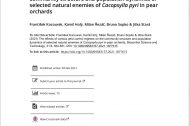Obsah
The effects of three different pest control regimes in three pear orchards (two with integrated pest management regimes and one with an organic farming regime) on communities of arthropods were studied in a two-year experiment. Insects were collected in three stages by beating the lower branches of trees. The number of species and other taxa of natural enemies increased with the reduction in insecticide applications. A total of 2,492 individuals of 145 species and other taxa were found in the samples from the three pear orchards with different pest management practices. The most numerous groups were Araneae, with 44 species, and Coleoptera, with 42 species, followed by Hymenoptera, with 33 taxa, and Heteroptera, with 24 species. Of the total number of taxa, the share of entomophagous arthropods was, on average, 62.6%. The share of predaceous individuals was, on average, 63.7% of the total number of individuals. The number of dominant predaceous species decreased with an increase in the diversity of species and other taxa. A significant relationship was found between the number of C. pyri adults and the Shannon-Wiener index of diversity for the predaceous taxa. It was demonstrated that generalist predators and their diversity have an important influence on the regulation of pear psylla in the vegetative period.



